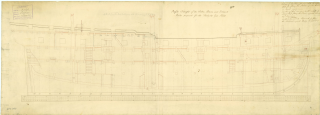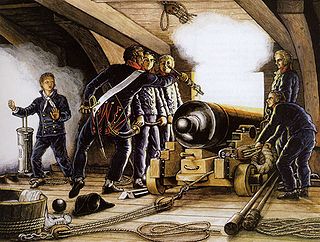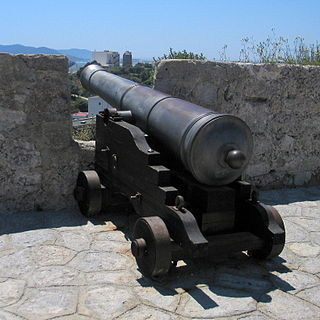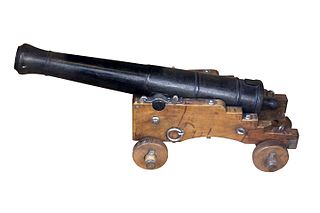History
The French Navy used "64-gun" as a typology for its ships. In the British Royal Navy, such lighter two-deckers were considered to be Third-rates, like 74-guns and 80-guns.
During the reign of Louis XIV, numerous ships carried 60 or 62 guns, with a lower battery pierced for 12 guns on each side. During the reign of Louis XV, standardisation efforts were undertaken to rationalise the design and construction of these ships, with a common armament of 24-pounder, 12-pounder and 8-pounder long guns. The first 64-gun in this sense was Borée, launched in 1734 and pierced with 13 gun ports on each side of her lower battery.The British started copying these ships from 1764 with HMS Asia, and also stopped building 60-gun ships. British ships had a slightly heavier broadside, as they typically carried 18-pounders on their upper gundeck, while the French would usually have 12-pounders.
64-guns were no match for 74-guns, which had a 36-pounders (in France) or 32-pounders (in England) lower battery and 18-pounders on the upper gundeck (some later units even experimented with 24-pounders in the upper deck), and were usually slower than frigates. Their main advantage were their cheaper cost, and lower draft. This would be especially important for operations in India.
The French built 61 of these 64-gun ships, the last one being Jason in 1779. Three were razeed, turning them into frigates capable of carrying a 24-pounder main armament, although these ships typically fell back to 18-pounders like most heavy frigates of their time.
The British built 43, and maintained production a while longer, as 64-guns were useful for escorting merchant convoys. The last British 64-gun to be launched was HMS Veteran, in 1787.

A frigate is a type of warship, having various sizes and roles over time.

Steam frigates, also known as screw frigates and the smaller steam corvettes and steam sloops, were steam-powered warships that were not meant to stand in the line of battle. The first such ships were paddle steamers. Later on the invention of screw propulsion enabled construction of steam-powered versions of the traditional frigates, corvettes, and sloops.

HMS Cornwall was an 80-gun, third rate, ship of the line built for the Royal Navy in the 1690s. She served in the War of the Grand Alliance, and in her first year took part in the Battle of Barfleur and the action at La Hougue.

Bretagne was a large 110-gun three-decker French ship of the line, built at Brest, which became famous as the flagship of the Brest Fleet during the American War of Independence. She was funded by a don des vaisseaux grant by the Estates of Brittany. She was active in the European theatres of the Anglo-French War and of the French Revolutionary Wars, notably taking an important role in the Glorious First of June. Later, she took part in the Croisière du Grand Hiver and was broken up.

The Combat de la Martinique, or Battle of Martinique, was a naval encounter on 18 December 1779 between a British 13-ship squadron under Admiral Hyde Parker and a 3-ship French divison under Admiral Lamotte-Picquet near the island of Martinique in the West Indies.
Constant Warwick was a 32-gun fourth-rate frigate which served in the English Royal Navy, built by Peter Pett I at Ratcliff and launched in 1645. She is sometimes regarded as the 'first English frigate', although a number of vessels built or acquired earlier also merit a similar description. The term 'frigate' during the period of this ship referred to a method of construction, rather than a role which did not develop until the following century.
HMS Falmouth was a 50-gun fourth-rate ship of the line built for the Royal Navy in the first decade of the 18th century. The ship participated in several battles during the War of the Spanish Succession (1701–15) and the War of Jenkins' Ear (1739–48).
The 1719 Establishment was a set of mandatory requirements governing the construction of all Royal Navy warships capable of carrying more than 20 naval long guns. It was designed to bring economies of scale through uniform vessel design, and ensure a degree of certainty about vessel capability once at sea, and was applied to all vessels from the first-rate to the fifth-rate. Once in effect, it superseded the 1706 Establishment, which had specified major dimensions for ships of the second-rate, third-rate and fourth-rate only.

HMS Vengeance was originally the 48-gun French Navy frigate La Vengeance and lead ship of her class. She engaged USS Constellation during the Quasi-War, in an inconclusive engagement that left both ships heavily damaged. During the French Revolutionary Wars, HMS Seine hunted Vengeance down and captured her after a sharp action. She was recommissioned in the Royal Navy as the 38-gun fifth rate HMS Vengeance, but the British apparently never returned her to seagoing service. Accounts are divided as to her eventual fate. She may have been broken up in 1803 after grounding in 1801, or continued as a prison ship until 1814.

USS Constellation vs L'Insurgente, or the Action of 9 February 1799, was a single-ship action fought between frigates of the French Navy and the United States Navy during the Quasi-War, an undeclared war that lasted from 1798 to 1800. The battle resulted in USS Constellation's capture of L'Insurgente, after an intense firefight in which both sides exchanged heavy broadsides and musket fire.

HMS Pallas was one of the three 36-gun Venus-class fifth-rate frigates of the Royal Navy. She was launched in 1757 and served until her loss in 1783.

The Action of 28 June 1803 marked the opening shots of the Blockade of Saint-Domingue after the collapse of the Treaty of Amiens and the outbreak of the War of the Third Coalition in May 1803.

The 18-pounder long gun was an intermediary calibre piece of artillery mounted on warships of the Age of sail. They were used as main guns on the most typical frigates of the early 19th century, on the second deck of third-rate ships of the line, and even on the third deck of late first-rate ships of the line.

The 24-pounder long gun was a heavy calibre piece of artillery mounted on warships of the Age of sail, second only to the 36-pounder long gun. 24-pounders were in service in the navies of France, Spain, Great Britain, the Netherlands, Sweden, and the United States. They were comparable to the Canon de 24 Gribeauval used by the French Army as its largest piece of siege artillery. 24-pounders were used as main guns on the heaviest frigates of the early 19th century and on fourth-rate ships of the line, on the second deck of first-rate ships of the line, and on the second deck of a few large third-rates.

The 12-pounder long gun was an intermediary calibre piece of artillery mounted on warships of the Age of sail. They were used as main guns on the most typical frigates of the early 18th century, on the second deck of fourth-rate ships of the line, and on the upper decks or castles of 80-gun and 120-gun ships of the line. Naval 12-pounders were similar to 12-pound Army guns in the Gribeauval system: the canon lourd de 12 Gribeauval, used as a siege weapon, and the canon de 12 Gribeauval, which was considered a heavy field artillery piece.

A gunport is an opening in the side of the hull of a ship, above the waterline, which allows the muzzle of artillery pieces mounted on the gun deck to fire outside. The origin of this technology is not precisely known, but can be traced back to the late 15th century, with the appearance of artillery in naval warfare. Ships featuring gunports were said to be pierced, since the ports were cut through the hull after the construction.

Brillant was a 64-gun Solitaire-class ship of the line of the French Navy.

The 8-pounder short gun was a light calibre piece of artillery mounted on French warships of the Age of sail. They were used as main guns on light ships of the early 19th century, and on the quarterdeck and forecastle of ships of the line. They were similar in design to the Canon de 8 Gribeauval.
Chesma was an 84-gun ship of the line built for the Black Sea Fleet of the Imperial Russian Navy in the 1840s. Rostislav carried a battery primarily consisting of tradition shot-firing guns, but she also carried four new shell-firing guns. The ship saw combat during the Crimean War at the Battle of Sinop against an Ottoman squadron in 1853, where the Russian shell guns proved to be decisive. The battle prompted Britain and France to intervene to support the Ottomans, leading the Russian fleet to withdraw to Sevastopol to avoid a battle with an Anglo-French fleet. Chesma helped to defend Sevastopol, supporting Russian ground forces during a battle in February 1855 before being disarmed to strengthen the city's defenses and then scuttled to block the harbor entrance to the Anglo-French fleet in August.

HMS Melpomene was a 38-gun frigate of the Royal Navy. Originally a French vessel, she was captured at Calvi on 10 August 1794 and first saw British service in the English Channel, where she helped to contain enemy privateering. In October 1798, she chased a French frigate squadron sent to find the French fleet under Jean-Baptiste-François Bompart, that was routed at the Battle of Tory Island and in August 1799, she joined Andrew Mitchell's squadron for the Anglo-Russian invasion of Holland.

















